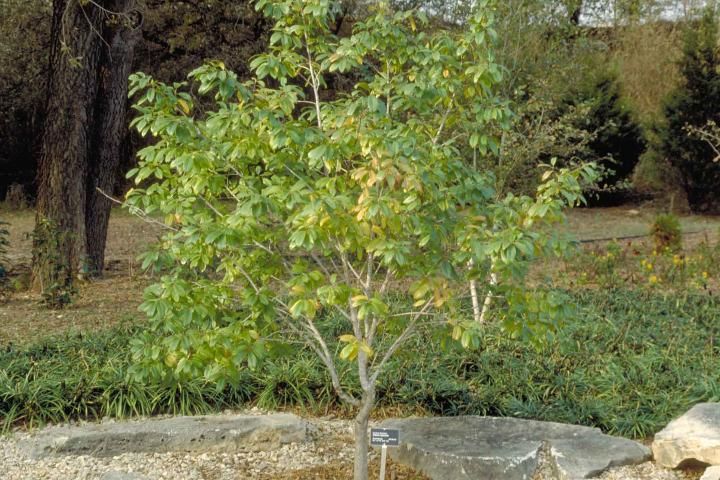Introduction
Carolina buckthorn develops an open crown of many slender branches and is usually seen at 12 to 15 feet in height although it is capable of reaching 40 feet in a partially shaded location. The bright green, deciduous leaves change to a gorgeous orange/yellow or red in autumn before dropping. The fairly inconspicuous, early summer flowers are greenish-white and followed by small, showy red fruits which ripen to black in the fall when their flesh becomes sweet and edible. Birds find the fruits irresistible. The thin, smooth bark is gray with dark markings. Carolina buckthorn is quite attractive in the landscape and is one of the first fruiting plants to show color.

Credit: Ed Gilman, UF/IFAS
General Information
Scientific name: Frangula caroliniana
Pronunciation: FRAYN-goo-luh kair-oh-lin-ee-AY-nuh
Common name(s): Carolina buckthorn
Family: Rhamnaceae
USDA hardiness zones: 5A through 9B (Figure 2)
Origin: native to North America
Invasive potential: native
Uses: hedge; trained as a standard; reclamation; highway median; deck or patio; specimen; container or planter

Credit: UF/IFAS
Description
Height: 12 to 15 feet
Spread: 10 to 15 feet
Crown uniformity: irregular
Crown shape: oval
Crown density: open
Growth rate: moderate
Texture: medium
Foliage
Leaf arrangement: alternate (Figure 3)
Leaf type: simple
Leaf margin: entire, serrulate
Leaf shape: oblong, elliptic (oval)
Leaf venation: pinnate
Leaf type and persistence: deciduous
Leaf blade length: 2 to 4 inches, 4 to 8 inches
Leaf color: green
Fall color: orange, red
Fall characteristic: showy

Credit: Marc Frank, UF/IFAS
Flower
Flower color: yellow
Flower characteristics: not showy
Fruit
Fruit shape: round
Fruit length: less than 0.5 inch
Fruit covering: fleshy
Fruit color: black, red
Fruit characteristics: attracts birds; showy; fruit/leaves not a litter problem
Trunk and Branches
Trunk/bark/branches: branches droop; not showy; typically multi-trunked; thorns
Pruning requirement: needed for strong structure
Breakage: resistant
Current year twig color: brown
Current year twig thickness: thin
Wood specific gravity: unknown
Culture
Light requirement: full sun, partial sun, or partial shade, shade tolerant
Soil tolerances: clay; sand; loam; alkaline; acidic; well-drained
Drought tolerance: high
Aerosol salt tolerance: unknown
Other
Roots: not a problem
Winter interest: no
Outstanding tree: no
Ozone sensitivity: unknown
Verticillium wilt susceptibility: unknown
Pest resistance: resistant to pests/diseases
Use and Management
Use this small tree or large shrub in a shrub border to attract birds and for a late summer accent. It can be planted in mass to form a thicket which should provide food and cover for a variety of wildlife. It might also be tried as a street tree where overhead space is restricted by power lines.
Carolina buckthorn should be grown in full sun on well-drained soil, acid or alkaline. It is moderately drought-tolerant.
Propagation is by seed.
Pests
No pests are of major concern.
Diseases
Susceptible to crown rust of oats. A leaf spot will occasionally infect the tree but is of no consequence.